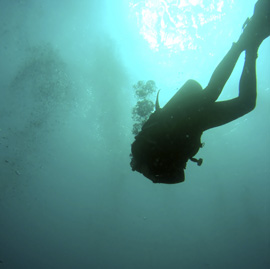Go with the Flow: The Basics of Drift Diving
Posted: Sep 14 in Dive Blog tagged Specialty Diving by Jan Imagine yourself gliding effortlessly through the ocean, flying past coral reefs like a dolphin with a jetpack. Though this dive is taking you further and faster than you’ve ever gone before, there’s no need to kick your feet—you’re free to ride the current and enjoy the passing sights.
Imagine yourself gliding effortlessly through the ocean, flying past coral reefs like a dolphin with a jetpack. Though this dive is taking you further and faster than you’ve ever gone before, there’s no need to kick your feet—you’re free to ride the current and enjoy the passing sights.
If you’ve recently received your scuba certification in Illinois, you’ve opened the door to countless opportunities for exciting underwater exploration. After your initial scuba certification class you can continue to diversify your diving skills by taking specialty diving courses that expose you to the many different ways to take your dive further. From night diving to underwater photography, there’s no shortage of ways to put a new spin on your scuba experience—but drift diving may be the most fun.
During a drift dive, you’ll take advantage of the ocean’s currents to experience what it truly feels like to fly underwater. By exploring ocean areas with known currents, you can minimize your effort and maximize your distance and time, taking in the scenery as you’re carried parallel to stunning reefs and aquatic wildlife. But just as with any dive, preparation and education are essential to keeping your scuba experience as safe and enjoyable as possible.
If you’re ready to learn more about drift diving after getting your Illinois scuba certification, the best way to do so is to take a class. Still, the following tips may help you start to learn the basics of drift diving and prepare for the excitement that awaits you:
- Follow the flow. If your dive exit point is somewhere up current you may find battling a strong current can easily wear you out and deplete your air supply faster. As such, the first step in a successful drift dive is to let the current take you. When you do so, you’ll you have no need to propel yourself—your fins will be primarily used for steering. By going with the flow, you’ll find yourself able to go further more quickly and efficiently.
- Keep it clear. High visibility and strong currents often do not go hand in hand, but it’s important to drift dive in the clearest possible waters to keep the current from propelling you into an obstacle. Be sure that visibility is high enough to anticipate and avoid potential dangers ahead. Because it’s easy for divers to get separated in strong currents, you’ll also want to make sure you can see every member of your diving group at all times.
- Stay safe. One key to drift dive safety is having friends on the surface. For any drift dive, you’ll need a capable boat captain above you, one who knows which way the current is flowing and how to follow as it carries you. You’ll also need a spotter who can alert the boat’s driver when a diver has ascended to the surface, making for quick pick-ups for any diver who separates from the group or is ready to be retrieved. To help your friends in the boat, it is a normal safe diving practice to trail a surface float behind you, while all drift divers should also carry a deployable, high-visibility buoy (safety sausage) and whistle or other audible signaling device.
Of course, there’s more to drift diving than these three tips. Before embarking on any drift dive, it’s best to prepare yourself for the challenge by enrolling in a drift dive specialty course.
Have you gone drift diving after getting your scuba certification in Illinois? Tell us about your experiences in the comments below!
